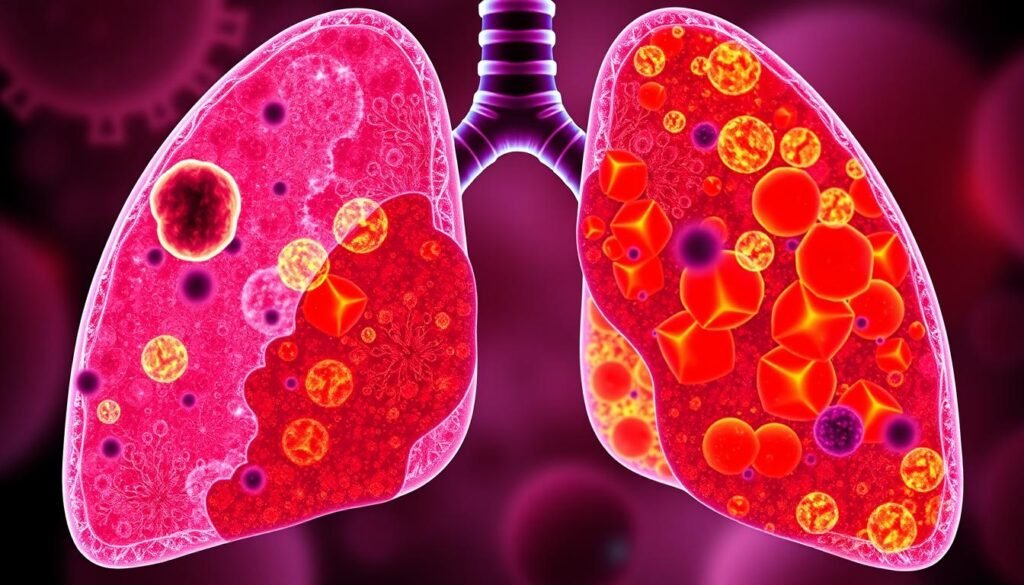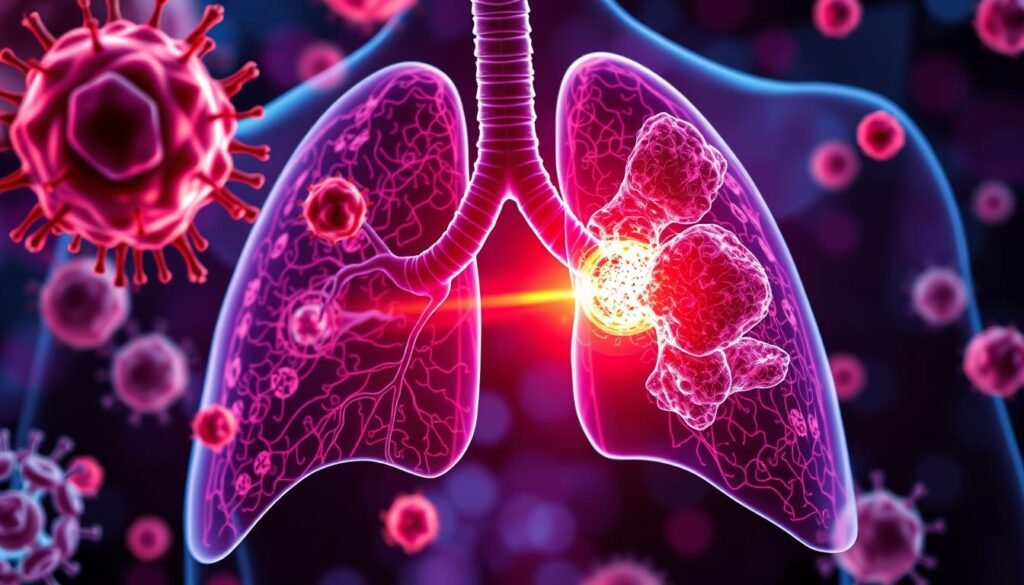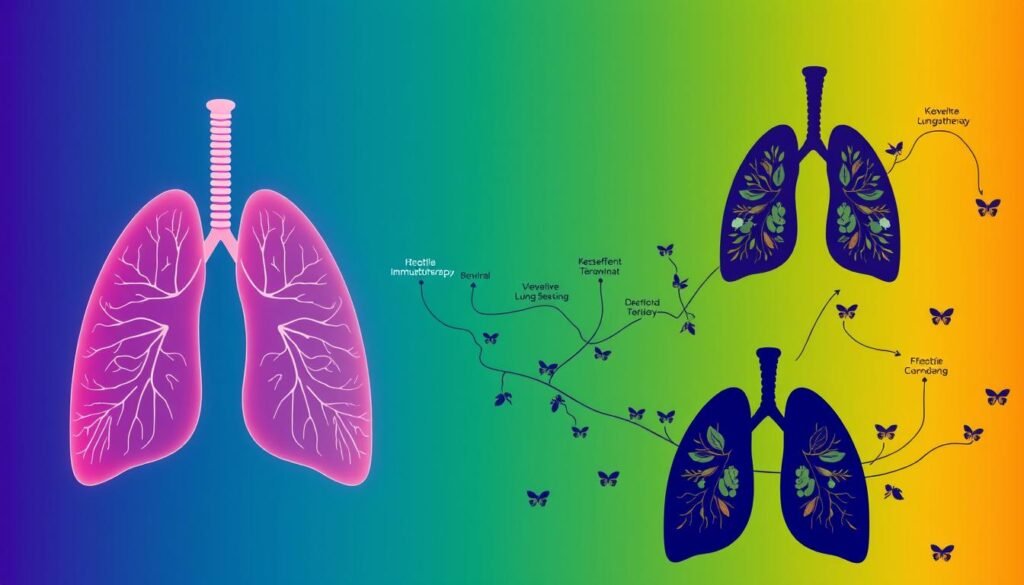Lung cancer is the top cancer diagnosis across the globe, representing 11.6% of all cancers. In 2022, the U.S. saw roughly 236,740 new cases and about 130,180 deaths. Despite progress in treatments like immunotherapy, patients face tough challenges, especially with the disease advancing post-treatment.
Treatments like surgery, radiation, chemotherapy, and targeted therapies sometimes meet resistance. Recent studies, including one in the New England Journal of Medicine, show immunotherapy as a good option that can possibly offer lasting benefits through immune memory. Yet, it’s essential to grasp how lung cancer can progress after immunotherapy to help patients better and craft improved treatment plans.
Key Takeaways
- Lung cancer accounts for 11.6% of global cancer cases.
- A significant number of patients experience treatment resistance, leading to disease progression.
- Immunotherapy shows potential for long-term survival in select lung cancer patients.
- Research continues to explore ways to enhance treatment efficacy in lung cancer care.
- Understanding disease progression is vital for improving patient outcomes.
Introduction to Lung Cancer and Immunotherapy
Lung cancer is one of the most common cancers worldwide. It makes up about 11.6% of all cancer cases. Traditional treatments include surgery, chemotherapy, and radiation. Now, there’s a growing interest in immunotherapy.
Immunotherapy is changing how we treat lung cancer. It uses the body’s immune system to fight cancer cells. This method has shown promise in creating strong immune reactions against tumors. It’s being used for both small cell lung cancer (SCLC) and non-small cell lung cancer (NSCLC), leading to better patient survival.
However, immunotherapy isn’t perfect. Some patients may see their disease get worse quickly. Things like overall health and past treatment success can affect results. It’s key to understand these factors to improve lung cancer treatments.
For more in-depth information on the progress of immunotherapy, visit this article.
Overview of Lung Cancer Types
Lung cancer is a big issue worldwide. Every year, it affects about 2.1 million people. Sadly, it leads to around 1.7 million deaths. This makes it the most common cancer globally. Lung cancer comes in two main types: non-small cell lung cancer (NSCLC) and small cell lung cancer (SCLC). NSCLC makes up about 85-90% of all cases. SCLC accounts for 10-15% of them.
NSCLC breaks down into three types: adenocarcinoma, squamous cell carcinoma, and large cell carcinoma. Adenocarcinoma is found in 40% of lung cancer cases. Squamous cell carcinoma follows at 25-30%, and large cell carcinoma is 10-15%. These categories help doctors pick the right treatment.
SCLC grows quickly and spreads fast. Those with SCLC usually find out late, which makes treatment harder. Most people with lung cancer are diagnosed at stage 3b/4 or higher. At these stages, regular treatments don’t work well.
The difference between SCLC and NSCLC affects how doctors treat it. NSCLC gives more choices for targeted therapies and immunotherapies compared to SCLC. Immunotherapy is a new treatment that’s changing the game in fighting lung cancer.
| Lung Cancer Type | Percentage of All Cases | Common Subtypes |
|---|---|---|
| Non-Small Cell Lung Cancer (NSCLC) | 85-90% | Adenocarcinoma, Squamous Cell Carcinoma, Large Cell Carcinoma |
| Small Cell Lung Cancer (SCLC) | 10-15% | None (typically classified as extensive or limited stage) |
What is Immunotherapy?
Cancer immunotherapy is a new method fighting cancer. It uses the body’s immune system to find and kill cancer cells. It includes treatments like immune checkpoint inhibitors and therapeutic vaccines to boost the immune response to tumors.
Immune checkpoint inhibitors stop certain proteins that keep the immune system from attacking cancer. This lets the immune system better target tumors. For lung cancer, pembrolizumab (Keytruda) works well with chemotherapy. Studies show patients treated with pembrolizumab had a 51% lower death rate than those with chemotherapy alone. After 10.5 months, 69.2% of the pembrolizumab group were still alive at the 12-month mark.
Therapeutic vaccines trigger a strong immune reaction against tumor markers. They teach the immune system to fight cancer’s unique traits. Combining these vaccines with immune checkpoint inhibitors offers better treatment plans. This is true for diseases like non-small cell lung cancer (NSCLC) and small cell lung cancer (SCLC).
New immunotherapy options are being developed all the time. Trials of nivolumab and ipilimumab show better survival for patients with high tumor mutations. These findings show the need for personalized treatment in cancer immunotherapy.
Using these therapies with traditional ones like chemotherapy and radiation fights cancer on all fronts. It improves the chances of beating the disease and enhances life quality. For more on how radiation therapy helps, check out this guide.
Mechanism of Action of Immunotherapy in Lung Cancer
Immunotherapy in lung cancer boosts the body’s defenses to kill cancer cells. It activates T-cells that spot and fight cancer. Immune checkpoint inhibitors, like PD-1 and PD-L1, are key. They remove blocks cancer puts on the immune system. This helps the body fight cancer harder.
Knowing how immunotherapy works is key in lung cancer treatment. It makes current treatments work better. It also helps the body remember how to fight cancer in the future. This could mean patients live longer, especially according to clinical trial data.
It’s important to watch lung health during treatment. Radiation therapy can control cancer but might cause problems. Patients might have trouble breathing or cough a lot. It’s very important to catch and treat these issues early. Paying attention to these problems can make a big difference for patients. For more details, look at this resource.
Importance of Biomarkers for Lung Cancer
Biomarkers are crucial when dealing with lung cancer. They help doctors craft personalized medicine plans for each person. Things like PD-L1 levels and EGFR mutations guide the treatment choices for those with lung cancer.
Patient-specific biomarker profiles let doctors predict how well someone will respond to treatments like immunotherapy. For example, pembrolizumab works better in patients with high PD-L1. But, not everyone responds well, showing we need to find even more biomarkers.
Research is now showing how combining different biomarkers, like those found in blood, can give us clearer answers. Markers such as ctDNA and bTMB could tell us who will benefit from immunotherapy. A comprehensive look at these markers offers better personalized medicine strategies.
Using biomarkers helps doctors tailor treatment options for lung cancer patients. This leads to better care and possibly longer lives for patients.
| Biomarker | Clinical Impact | Response Rate |
|---|---|---|
| PD-L1 expression | Guides immunotherapy selection | 19-45% |
| EGFR mutations | Influences response to ICIs | Variable based on mutation type |
| Tumor Mutational Burden (TMB) | Predicts immunotherapy efficacy | 31.4% for high TMB |
| Circulating tumor DNA (ctDNA) | Reflects tumor dynamics | Promising in predicting outcomes |
Lung Cancer Progression After Immunotherapy
Lung cancer’s journey after immunotherapy is shaped by many factors. These factors play a big role in treatment outcomes. Research shows that changes can happen even after initial success with treatments known as immune checkpoint inhibitors (ICIs).
Understanding Disease Progression
The rate at which lung cancer progresses varies from person to person. Those treated with ICIs often see a high initial success rate of about 85.4%. But, keeping the disease under control over the long term is challenging.
For those who complete two years of ICI therapy, we see promising signs. At 12 months, 81.1% did not see their disease get worse. And 96.4% were still alive, which is encouraging.

Factors Affecting Progression Rates
A lot of factors play into how lung cancer progresses after immunotherapy. The nature of the tumor is crucial. About 50.4% of patients develop what’s called acquired resistance (AR) after an average of 10.7 months.
The disease stage when therapy starts also makes a big difference. People with fewer cancer sites had longer survival rates. They lived about 18.9 months, whereas those with more widespread disease lived about 8.8 months.
Also, personal traits like age and smoking history matter. Older individuals and former smokers might face more hurdles during treatment. Recognizing these aspects helps doctors make better treatment plans for their patients.
Immunotherapy Side Effects and Patient Management
Immunotherapy plays a big role in fighting cancer today. Understanding and handling its side effects is key to helping patients. While it’s a major leap in cancer care, it can cause side effects. So, it’s important to manage these effectively.
Common Side Effects
Immunotherapy drugs, such as immune checkpoint inhibitors, may cause a range of side effects. For example:
- Fatigue
- Skin rash
- Diarrhea due to colon irritation
- Endocrine disruptions affecting glands
- Pneumonitis, leading to breathing issues
- Arthralgia or joint pain
Side effects can vary. They might be mild or serious. Some people might see symptoms soon after starting treatment. For others, it might take months.
Managing Treatment-Related Adverse Events
To manage immunotherapy side effects well, constant monitoring is crucial. Methods to handle side effects include:
- Keeping a close eye on symptoms and health.
- Using medications like corticosteroids for serious reactions quickly.
- Doctors, primary care physicians, and support teams working together.
- Educating patients about early signs of side effects.
Working together in these ways can make life better for patients. It lets them keep getting their treatment. Clear communication between patients and their care teams is essential. This way, any new issues can be dealt with right away.
Checkpoint Inhibitors: Role in Treatment
Checkpoint inhibitors have changed how lung cancer is treated. This is especially true for those with non-small cell lung cancer (NSCLC). Each year, over 200,000 people in the U.S. find out they have lung cancer. About 85% of these are NSCLC cases. Pembrolizumab and nivolumab are some of these inhibitors. They work by helping the immune system find and kill cancer cells. This method has been great for improving survival, particularly in advanced stages.
Nivolumab’s impact shows this well. It has an 18% response rate in NSCLC patients. Many see benefits lasting more than a year. The CheckMate-057 trial showed nivolumab users had a 51% survival rate at one year. This is better than the 39% survival rate seen with the usual chemotherapy like docetaxel. Moreover, nivolumab is less harmful, with fewer severe side effects than docetaxel.
Pembrolizumab was the first immunotherapy for initial treatment. It helps 19% of advanced NSCLC patients, and works even better with chemotherapy. This is true for patients with high PD-L1 expression levels. The PACIFIC trial showed the promise of durvalumab too. Patients getting this treatment had a survival of 47.5 months in stage III NSCLC.

Now, studies are mixing checkpoint inhibitors with other treatments to improve results. These efforts tackle treatment resistance and figure out how best to include these drugs in lung cancer care. Checkpoint inhibitors mark a major change in tackling lung cancer. They bring hope and better chances of survival for many.
| Treatment | 5-Year Survival Rate | Adverse Events (Grade 3-4) | Overall Response Rate |
|---|---|---|---|
| Nivolumab | 51% | 10% | 18% |
| Pembrolizumab | 19% (phase 1 study) | N/A | 19% |
| Docetaxel | 39% | 54% | N/A |
Tumor Response and Monitoring Techniques
Monitoring how tumors respond to immunotherapy is tricky. It requires the latest monitoring techniques. Doctors use many imaging techniques to see if a treatment works and to follow the disease’s progress. Good monitoring can help doctors change treatment in time. This might improve how well patients do.
Imaging Techniques for Monitoring Progression
Several imaging techniques are key in checking how tumors react. The ones often used include:
- CT scans
- PET scans
- MRIs
These techniques let doctors see changes in tumors well. This is key in knowing if treatment works. As treatment goes on, spotting trends like false progression or really quick disease growth is crucial. Usual ways to judge tumor response might not work well for immunotherapy.
Evaluating Treatment Efficacy
Doctors use new rules like irRC, irRECIST, and imRECIST to judge treatment effects. These changes aim to better capture how immunotherapy works. With these new rules, doctors can gauge tumor response more precisely. For example, irRC helps avoid stopping treatment too soon. It shows some patients may live longer if they keep on treatment, even if it first seems not to work.
New methods like liquid biopsies and better imaging tech give updates on tumors as they happen. These advances may help make monitoring better. This leads to treatment plans that are more tailored to each patient’s needs.
Survival Rates and Prognosis for Patients
Lung cancer survival rates vary widely. They depend on the cancer’s type, how early it’s found, and how well it responds to treatment. Recent studies show promising results for advanced non-small cell lung cancer (NSCLC) patients receiving immunotherapy. Compared to traditional treatments, immunotherapy has shown to extend overall survival. The median survival for immunotherapy patients hit 16.4 months. This is compared to 11.6 months for those on chemotherapy, according to data from the Windsor Regional Cancer Program.
The outlook for lung cancer, or its prognosis, is vital. It helps inform patients and their families about what to expect. A study revealed a 5-year survival rate of 11.1% and a median survival of 474 days. These numbers offer a snapshot of how patients might fare. New treatment strategies are helping to improve these survival rates, aiding patients in navigating their healthcare journey.
Recent data puts the median overall survival for patients on chemotherapy (Chemo1) at 19.2 months from diagnosis. For those on immunotherapy (Immuno1), it’s slightly less, at 18.4 months. These statistics highlight the importance of how and when treatments are applied. They significantly affect patient outcomes.
- Median overall survival (OS) for immunotherapy: 16.4 months
- Median OS for chemotherapy: 11.6 months
- Estimated survival rate at 3 years for ChemoImmuno1: 17.6%
- Estimated survival rate for Immuno1: 17.9%

Knowing these stats aids medical staff and families in choosing the best treatment plans. Ongoing research into treatments strives to better survival rates. This work aims to bring more hope and a better life quality to lung cancer fighters. For more on how immunotherapy affects treatment timing and results, check this article.
| Group | Median Overall Survival (months) | Estimated 5-Year Survival Rate |
|---|---|---|
| Chemo1 | 19.2 | 20.1% |
| Immuno1 | 18.4 | 17.9% |
| ChemoImmuno1 | 9.6 | 17.6% |
Challenges of Treatment Resistance
Treatment resistance is a big problem in lung cancer care, especially after immunotherapy. This problem takes different forms. For example, primary resistance varies widely depending on the patient’s treatment history. Patients who had standard chemotherapy first often see resistance rates of 21% to 27%. But, resistance rates drop to about 10% for those who start with ICIs and chemotherapy together.
Resistance rates soar for patients who get ICIs after failing chemotherapy. Secondary resistance also poses a big challenge. It affects nearly 65% of patients who first did well with immunotherapy. While 52%-57% of patients who get ICIs first develop resistance, those who get them as a second option face resistance rates of 32%-64%.
A study from Memorial Sloan Kettering Cancer Center showed something interesting among 1201 lung cancer patients. Among those, 78% of the 243 who initially responded to PD-1 inhibitors developed secondary resistance. Different types of cancer progression show different resistance patterns. Patients with minor progression tend to develop resistance later than those with extensive cancer spread. This suggests those with minor spread might have a better chance of survival.
The issue of resistance in lung cancer treatment affects how well treatments work and can lead to lower survival rates. With lung cancer causing about 1.8 million deaths globally each year, tackling resistance is crucial. Even with advancements like immunotherapy, understanding how tumors change and evade the immune system is key to better patient care and survival.
| Type of Resistance | Resistance Rate | Related Treatment Context |
|---|---|---|
| Primary Resistance | 21%-27% | Chemotherapy Preceding Immunotherapy |
| Primary Resistance | 10% | ICIs Combined with Chemotherapy (First-Line) |
| Secondary Resistance | 52%-57% | ICIs as First-Line |
| Secondary Resistance | 32%-64% | ICIs as Second-Line |
| Acquired Resistance | Up to 65% | Initial Responders in Clinical Trials |
| Oligo Progression | Varied | After PD-1 Inhibitor Treatment |
Conclusion
The field of lung cancer treatment is changing a lot because of new therapies. But, challenges like the cancer getting worse remain. It’s crucial to know how tumors work and to use special signs in patients to make treatments better. This can lead to longer lives and better health for those with lung cancer.
A study found that 62% of patients saw their cancer get worse after first treatments. Yet, those who got immunotherapy after getting worse had a longer life. Their median survival was 26.6 months, versus only 9.5 months for those who didn’t get more immunotherapy. This shows how important more research is for better treatments.
As this area grows, working together is key for scientists and doctors to find good ways to fight lung cancer. Their hard work will help discover new treatments. This will help patients respond better to therapy and have a brighter future.